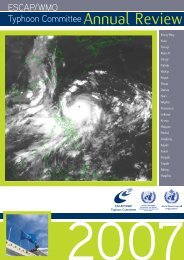TCAR - Typhoon Committee
TCAR - Typhoon Committee
TCAR - Typhoon Committee
You also want an ePaper? Increase the reach of your titles
YUMPU automatically turns print PDFs into web optimized ePapers that Google loves.
76<br />
ESCAP/WMO<br />
<strong>Typhoon</strong> <strong>Committee</strong> Annual Review 2009<br />
MALAYSIA<br />
2.0 Summary of progress in Key Result Areas<br />
2.1 Reduced Loss of Life from <strong>Typhoon</strong>-related<br />
Disasters.<br />
2.1.1 Meteorological Achievements/Results<br />
JMA-MMD Storm Surge Model<br />
Many improvements have been made in the Storm<br />
Surge Modelling at the Malaysian Meteorological<br />
Department (MMD).<br />
A new version of the storm surge model presently<br />
used at the MMD has been available from the Japan<br />
Meteorological Agency (JMA). The resolution of the<br />
new storm surge model is 1’. Other modifications<br />
have also been done such as usage of the<br />
“continuous calculation” methodology to calculate sea<br />
level rise and time series display for selected<br />
locations. Presently only wind barb images are<br />
being used.<br />
Recently MMD has managed to modify the JMA –<br />
MRI version 3 wave model and made it operational.<br />
Outputs such as significant wave height, swell and<br />
wind waves have been simulated for up to a period<br />
of 180 hours. Presently surface pressure and wind<br />
data from NOGAPS and NCEP are being used<br />
as initial conditions. Verification is done using<br />
reanalyzed data from NCEP, ERA40 data and JRA-<br />
25 data. MMD is trying to increase the area for<br />
the coarse mesh region so as to obtain more<br />
accurate boundary values for the fine mesh.<br />
2.1.2 Hydrological Achievements/Results<br />
Improvement of Facilities<br />
The Department of Irrigation and Drainage (DID)<br />
to date has installed and operated about 525<br />
telemetric stations in 38 river basins. In addition, 670<br />
manual river gauges, 1013 stick gauges and 182 flood<br />
warning boards have been set up in flood prone areas<br />
so as to provide additional information during the<br />
flood season. As part of the local flood warning<br />
system, about 395 automatic flood-warning sirens<br />
are being operated.<br />
An Integrated Flood Forecasting and Warning System<br />
(iFFRM) for the Klang Valley are being developed.<br />
For this system, 88 new telemetric stations and<br />
infrastructure networks will be installed together<br />
with a flood modelling system that include both<br />
hydrometeorology and hydrodynamic. To date, about<br />
99.5% of physical works on the infrastructure<br />
networks have been completed, while the progress<br />
for modelling has only reached 20%.<br />
As reported previously, Kuala Lumpur Stormwater<br />
Management and Road Tunnel Project (SMART) had<br />
been completed in July 2007. Since then, SMART<br />
had successfully diverted floodwater from entering<br />
Kuala Lumpur City Center. During these periods,<br />
there were at least 35 major storm events where the<br />
diversion of excess floodwater by the SMART<br />
system had saved Kuala Lumpur city center from<br />
the worst impact of flooding.<br />
2.1.3 Research, Training, and Other Achievements/<br />
Results<br />
Atmospheric Model-Based Rainfall & Flood<br />
Forecasting System (AMRFF)<br />
To improve the efficiency of flood forecasting in<br />
Malaysia, DID has embarked on the Atmospheric<br />
Model-Based Rainfall & Flood Forecasting System<br />
(AMRFF) project. This project is to be completed<br />
by November 2010. At present; the progress of the<br />
project is 25%.<br />
This project has two objectives:<br />
1. To develop real-time flood forecasting based<br />
on Atmospheric Model-based Rainfall and Flood<br />
forecasting (AMRFF) System for providing a realtime<br />
flood warning and emergency responses in a<br />
convenient lead-time to the Pahang, Kelantan and<br />
Johor River Basins.<br />
2. To develop radar rainfall analyzer and integrator<br />
for Malaysia (RAIM) to estimate rainfall distribution<br />
and the rainfall forecast magnitude in the Pahang,<br />
Kelantan and Johor River Basins.<br />
On The Job Training (OJT)<br />
The third OJT was held from 21 July until 23 August<br />
2009 at DID office (Hydrology and Water Resources<br />
Division), Kuala Lumpur, Malaysia. The programme<br />
was arranged for 23 days to cover all the modules<br />
that have been planned by the Department.<br />
The on-the job training program is to enable<br />
participants to:<br />
Gain knowledge, appreciation and experience on use<br />
of the Tank Model for flood forecasting<br />
Configure a flood forecasting model based on<br />
the Tank Model for a selected catchments in the<br />
participant’s country<br />
Calibrate the Tank Model and preparing the model<br />
for operational use in the participant’s respective<br />
organization Develop an error correction module<br />
for the Tank Model to enhance forecast accuracy

















